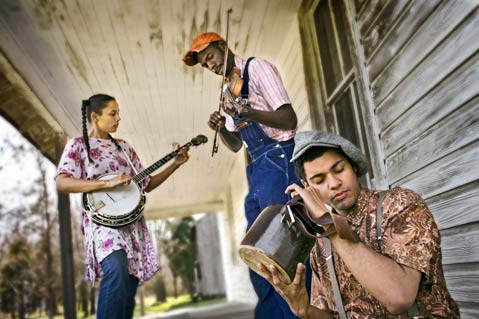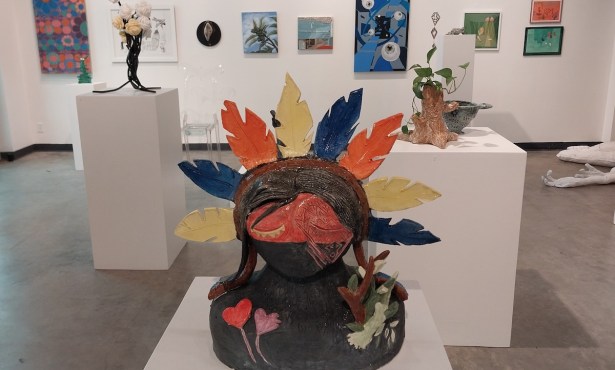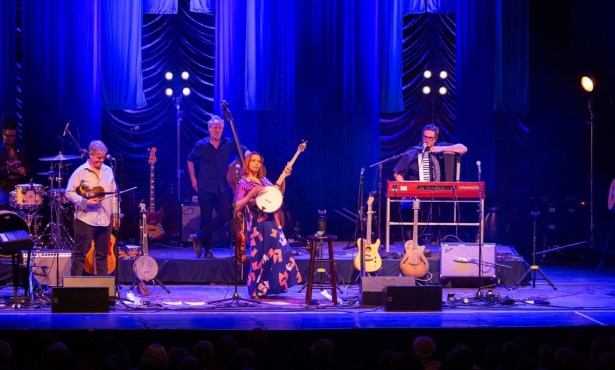Black Banjo Power
An Interview with the Carolina Chocolate Drops' Dom Flemons

Banjos are not necessarily the first instrument that comes to mind when we think about black music, but the African origins of this guitar and drum hybrid are widely acknowledged. In fact, most recently there has been a resurgence of interest (verging on a full-blown trend) in black banjo and old time string band music. What started in 2004 as a Yahoo online group called Black Banjo Players Then and Now burgeoned into a veritable movement after the first Black Banjo Players Conference was held in the spring of 2005. And the best-known young group to form out of that historic gathering was none other than the Carolina Chocolate Drops. A trio made up of Dom Flemons, Rhiannon Giddens, and Justin Robinson, the group have released several CDs on their own MusicMaker label and contributed four songs to the Atlantic Records soundtrack for The Great Debaters.
As this traditional African-American string band music continues to challenge many assumptions about race and musical genre, it also lays claim to a great beat you can dance to. In concert, the Chocolate Drops encourage their audiences to get up and dance if they feel like it, or sing along with the choruses. When it was first played, this music was “functional,” that is, part of daily life rituals of relaxation, courtship, and celebration. The way the Carolina Chocolate Drops approach it today, with the occasional odd touch-like covering contemporary hip-hop hits or adding Tuvan throat singing to an arrangement-there seems to be a good chance that this sound will live on to function as social music once again. The Drops play UCSB’s Campbell Hall this Friday night. I spoke with bandmember Dom Flemons about the show last week.
This is a very unusual project. How did you learn about this type of music? In terms of the string band, the fiddle and banjo stuff, all three of us came to it from different angles. Rhiannon [Giddens] was doing contradance and she ran into Cecelia Conway, the scholar who wrote the book African Banjo Echoes in Appalachia. Justin [Robinson] had played banjo as a kid, and he had been to some square dances, and he also read Conway’s book, and that got him thinking. And when I got into it I was doing a lot of old time music and blues.
How did the Carolina Chocolate Drops come together? At the Black Banjo Gathering-we were all called to that in spring of 2005. There were some African players there, and a dozen black string band players from all over America. It was the first time that all the black folks doing this music today were in the same place at the same time and got to hear and meet each other.
You encourage the audience to sing along and dance if they like. How does that work in a concert setting? Well, it’s more we are asking people to do it than telling them. Like when Pete Seeger would ask people to sing. It’s just giving them permission, but it’s not like we’re expecting that they will all want to get up. Once upon a time you could expect people to sing along and dance to this music, because originally that’s what it was for, so we like to at least keep the option open.
So you know the right way to dance to something like “Memphis Breakdown”? Oh yeah, there’re a lot of things you could do to “Memphis Breakdown.” You could two-step to it, you could Charleston to it, and you could do a slow drag and kind of drag your partner around the floor with it. There are actually a lot of old dances that could fit with a blues breakdown like that.
That’s fascinating. Is that aspect of the music important? Yes, it’s really important to know and to be able to do the dances if you are going to play this music. Of the other musicians that I know, I think today only maybe serious hip-hop deejays are forced to know exactly how people are going to dance to their music so clearly in order to create it because, like with this stuff, you have to know the steps to play it right.
I have heard Rhiannon sing Blu Cantrell’s song “Hit ‘Em Up Style” with the Chocolate Drops, and I can hear that it’s all dance music. It’s funny, the way she brought that song in, because when we put it together we just did it like all our other tunes. And then when we started to do it live, it became this bridge that allowed people into everything else we were doing. It made them realize that maybe things hadn’t changed that much, and that the old time music was not so remote.
Watching you perform I can tell that to play this music you have to be a good listener. Is that something you learned from jazz? Yes, old time jazz was part of my background, but in both string band music and in old time jazz, you don’t really improvise the way you do in modern jazz. You know when someone calls out, “Let’s do ‘The Saints'” in a traditional jazz band they expect you to play the notes, and not something new. So in that sense old time jazz and traditional string band music are actually not what I would call improvisational in the way that modern jazz is. It’s more that there’s a structure that we always go around, but each individual performance ebbs and flows within that. So what any single performance sounds like has something to do with how the audience is feeling and how we are feeling and what the environment’s like that night. Any of those things will change the way the song sits with us as a group, even though we are playing mostly the same notes as we always do.
You do some distinctive vocals on the track “Don’t Get Trouble in Your Mind.” What is that? I’m a big fan of Tuvan throat singing, and I really liked the film Genghis Blues, so when we were working on that song, and I tried to do this harmonica part while playing at the same time, and it wasn’t working, I just thought I would try this little Tuvan throat thing.
Wow, you added a Tuvan throat verse to a traditional Piedmont blues. That’s crazy. How is it taking this music on the road? It’s been a neat thing to see the reaction, because I started to play this music ten years ago, and at that time we were still just barely out of the wasteland for traditional music that was the 1980s and 1990s. But now it has come into its own again, and we are seeing people coming back to it, especially young people.
I really love the stripped-down sound of the banjo, violin, and guitar together. What is it about that instrumentation that makes it so special? Well, it’s simple, but it drives itself. It comes from a deep source. Like Shakespeare, the material contains everything it needs to be great, and all you’ve got to do as a player is pull it off. Then the rest will happen.
4•1•1
The Carolina Chocolate Drops play UCSB’s Campbell Hall on Friday, November 6 at 8 p.m. For tickets and information, call 893-3535 or visit artsandlectures.sa.ucsb.edu.



